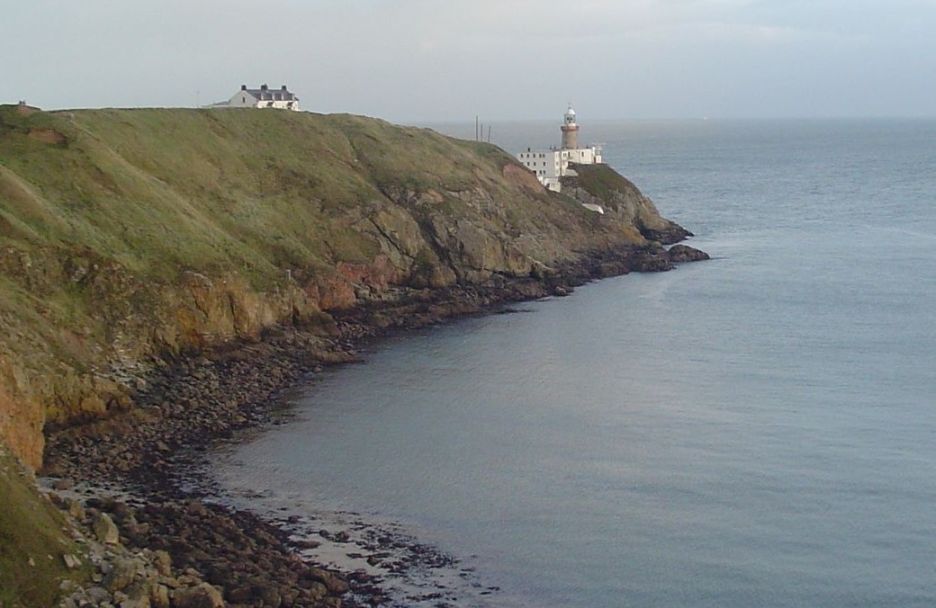- Baily Lighthouse
Infobox_Lighthouse
name = Baily Lighthouse

caption = Howth head Lighthouse Co Dublin
location =County Dublin
coordinates =
yearbuilt =
yearlit =
automated =
yeardeactivated =
foundation =
construction =
shape =
marking =
height =
elevation =
lens =
currentlens =
intensity =
range =
characteristic = The Baily Lighthouse, on the southeastern part ofHowth Head inDublin ,Ireland , is maintained by theCommissioners of Irish Lights .History
Early history
The first lighthouse on this site was built in about 1667 by Sir
Robert Reading , and was one of six that Reading had received letters patent to build from Charles II in 1665. The original facility consisted of a small cottage and a square tower which supported a coal-fired beacon. Parts of the original buildings remain. In 1790, the coal beacon was replaced with a set of sixArgand oil lamps, each including a silvered copper parabolic and a bulls-eye glass pane. During this period, the lighthouse was maintained by the Revenue Commissioners.New site
In 1810, the Corporation for Preserving and Improving the Port of Dublin took over the operations. The original building's location was high on the headland, so the light was often obscured by fog. On December 5, 1811 a recommendation was issued that the lighthouse be moved south on the headland to Little Baily, or
Dungriffen . A new tower and house for the keeper, designed byGeorge Halpin Senior, the corporations’s Inspector of Works, was completed on March 17, 1814. The top of the tower stood 134 feet (41 m) above the sea, and the fixed whitecatoptric light was provided by a set of 24 Argand lamps and reflectors .hipwrecks
The area was the scene of a number of shipwrecks. On August 3, 1846, the
City of Dublin Steam Packet Company 'spaddle steamer "Prince" ran into the cliffs about 2½ km north of Baily in heavy fog, and as a result it was decided that fog bells should be installed at the lighthouse. This work was delayed due to costs of other construction projects.The most notable wreck was the tragedy of the PS "Queen Victoria" on February 15, 1853, in which over 80 passengers and crew died. The fog bell was finally installed in April, 1853, as a result of the "Queen Victoria" shipwreck and its subsequent
Board of Trade inquiry.Improvements
In 1865, the light source was improved from catoptric to first order
dioptric . At the same time,John Richardson Wigham had patented a gas-burning light, so experiments with this new system were tried at Baily. A gas works was built at the station to produce the fuel, first from oil, then shale, and finally rich cannel coal. The experiments were a success, and the system was added to nine other lighthouses.An air horn was installed in 1871 for times of fog, which was replaced with a siren in 1879. The bell was kept as a standby system until 1890. The siren was replaced by a
diaphone in 1926.In 1892, two additional homes for Assistant Keepers were built. In 1902, a system was installed that caused the gas light to flash once every 30 seconds, instead of shining continually. In 1908, the gas light was replaced with one using incandescent vaporised paraffin. In 1953, a larger house was built for the Principal Keeper below the lighthouse.
Operations in modern times
In June, 1972, the system was electrified, with a 1,500 watt bulb in a rotating lens, producing a flash every 20 seconds that can be seen at a range of convert|26|nmi|km. In 1973, additional dwellings for Supernumerary Assistant Lighthouse Keepers were built, as the Baily lighthouse became a training facility for Supernumerary Assistant Lighthouse Keepers who would then transfer to other lighthouses.
Modern technology made light a secondary warning system, and a radiobeacon became the primary method of warning ships. Starting in 1978, the light was operated only in poor visibility, along with the fog signal. The fog signal was finally discontinued in 1995.
In late 1996, the lighthouse was converted to automatic operation, and the last of the Keepers left on March 24, 1997, making Baily the last Irish lighthouse to go automatic. Radiobeacon service was discontinued in 1999, and at the same time, radar and additional communications equipment was installed. Although officially an automatic station, an attendant still lives in the Principal Keeper's residence.
Museum
In 2000, a small museum was established in the reworked buildings by the Commissioners of Irish Lights, including small artefacts gathered from retired staff. This museum is not open routinely but by arrangement for staff and former staff, and their families, and small interest groups.
References
* [http://www.cil.ie/flat_areaEQLlighthousesAMPLighthouseIDEQL19_entry.html The Commissioners of Irish Lights webpage]
See also
*
Lighthouses in Ireland
Wikimedia Foundation. 2010.
